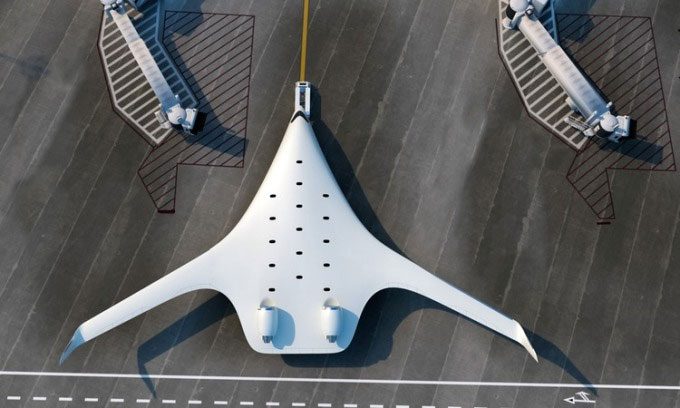The design of blended-wing aircraft has great potential to reduce fuel consumption and emissions but comes with significant challenges.
The basic design of commercial aircraft has remained unchanged for the past 60 years. Modern airplanes like the Boeing 787 and Airbus A350 share the same general shape as the Boeing 707 and Douglas DC-8, produced in the late 1950s, reinforcing the tube-and-wing design that is prevalent today, according to CNN. This is because commercial aviation prioritizes safety, leaning towards proven and tested solutions. Additionally, other developments in materials and engines still align with traditional designs. However, in the quest to reduce carbon emissions, the aviation industry faces greater challenges than other industries due to its reliance on core technology.

JetZero hopes to bring blended-wing aircraft into operation by 2030. (Photo: JetZero).
One solution is the blended-wing design. This entirely new aircraft shape resembles the flying wing design used by military aircraft such as the B-2, but with significantly larger wing volume in the middle section. Both Boeing and Airbus are intrigued by the idea. Another company, JetZero based in California, also aims to have blended-wing aircraft operational by 2030. According to Tom O’Leary, co-founder and CEO of JetZero, this type of aircraft could reduce fuel consumption and emissions by 50%.
The concept of a blended wing is not new. Efforts to create aircraft based on this design date back to the late 1920s in Germany. American industrialist and aircraft designer Jack Northrop created such a vehicle in 1947, inspiring the development of the B-2 bomber in the 1990s.
Blending the flying-wing style with traditional tube-and-wing designs, the blended-wing design allows the entire aircraft to generate lift, minimizing drag. NASA has stated that such a design improves fuel efficiency and creates a larger cargo or passenger area in the middle of the fuselage. They have tested the design on the X-48 experimental aircraft.
Through over 120 test flights from 2007 to 2012, two remote-controlled X-48 unmanned aircraft demonstrated the feasibility of the design. This type of aircraft would have a wingspan slightly larger than that of a Boeing 747 and could operate within existing airport terminals. According to NASA, blended-wing aircraft are also lightweight, produce less noise and emissions, and have lower operating costs compared to conventional transport aircraft. In 2020, Airbus constructed a small blended-wing aircraft measuring approximately 1.8 meters and expressed interest in developing full-sized aircraft in the future.
According to O’Leary, a technical challenge causes hesitation among manufacturers. “There is pressure on the non-cylindrical fuselage. Cylindrical aircraft better withstand the frequent expansion and contraction cycles that accompany each flight. The tube-and-wing design separates pressure loads on the fuselage and wings. But the blended-wing design connects the two components together. Currently, we can only manage this with composite materials that are both lightweight and durable,” O’Leary noted.
The new shape will make the interior of the aircraft look quite different from today’s wide-body planes. With the same number of passengers, a blended-wing aircraft could have 15 to 20 rows of seats along the cabin, depending on the configuration chosen by each airline. O’Leary believes that the aircraft most comparable in size to the blended-wing aircraft is the Boeing 767. This twin-engine wide-body aircraft, introduced in the 1980s, can carry approximately 210 passengers. JetZero aims to develop three versions of blended-wing aircraft simultaneously for passenger transport, cargo, and fuel transportation. The first flight is scheduled for 2027.
However, manufacturing a completely new aircraft from scratch is a monumental task. JetZero’s goal appears ambitious, as the entire process of obtaining full certification for even an existing aircraft takes many years. One advantage JetZero has is that the initial aircraft model will utilize engines from narrow-body planes like the Boeing 737 before transitioning to zero-emission engines powered by hydrogen.
Overall, the blended-wing design is a revolutionary idea with significant potential, but it also comes with numerous hurdles, particularly the increased aerodynamic complexity that makes the design and testing process challenging, regulatory and certification issues, and the shape may not be compatible with current airport infrastructure.


















































